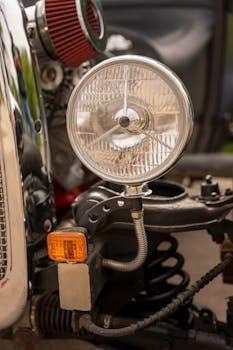The oil bath air cleaner‚ a vintage design‚ saw widespread use in older vehicles and machinery. Understanding their function and upkeep remains relevant. This guide focuses on the removal process‚ a crucial step in servicing these durable air cleaners. Servicing involves removing the unit from the engine.

Understanding Oil Bath Air Cleaners
Oil bath air cleaners are ingenious systems. They use oil to trap dirt before it reaches the engine. Airflow draws oil upwards‚ coating metal shavings. The oil’s viscosity captures contaminants. Though replaced by modern filters‚ their efficiency and dirt capacity were advantageous for heavy duty applications in dusty environments.
How Oil Bath Air Cleaners Work
Oil bath air cleaners operate on a simple yet effective principle. Incoming air is forced to change direction‚ impacting an oil reservoir at the base of the cleaner. This action lifts oil droplets into the airflow. The oil-laden air then passes through a mesh or wire wool filter element.
Dirt and contaminants in the air become trapped by the oil. Cleaned air then proceeds to the engine’s intake. The oil‚ now carrying the captured dirt‚ drains back down into the reservoir. This process continuously cleans the incoming air‚ ensuring that the engine receives a supply of clean air for combustion.
The oil bath design is particularly effective in dusty conditions. It can hold a significant amount of dirt relative to its size without losing efficiency. The oil acts as a scrubbing agent‚ continuously removing contaminants from the air stream. Regular servicing is important to remove accumulated dirt and maintain optimal performance‚ often involving solvent cleaning.

Servicing Your Oil Bath Air Cleaner
Regular servicing is critical for optimal performance of oil bath air cleaners; The frequency depends on operating conditions. Dusty environments require more frequent attention. Servicing involves removing accumulated dirt‚ cleaning components‚ and refilling with fresh oil to ensure efficient air filtration.
Determining Service Intervals
Establishing appropriate service intervals is key to maintaining the effectiveness of your oil bath air cleaner. The ideal interval hinges significantly on the operating environment. Vehicles or equipment used in dusty conditions necessitate more frequent servicing compared to those in cleaner environments. Historically‚ a service interval of every 2‚000 miles was suggested for vehicles operating in dusty areas. However‚ in extremely dusty conditions‚ an oil bath air cleaner may require servicing as regularly as once a day.
Regular inspection of the oil within the cleaner can also guide your service schedule. If the oil appears excessively dirty or sludgy‚ it’s a clear indication that servicing is due‚ regardless of the mileage or time elapsed. Consider the typical usage and environmental factors to tailor a schedule. If performance declines‚ service it immediately.
For normal driving conditions‚ the service interval may be 2‚000 to 3‚000 miles. Keep a record of your service dates to track and refine your service intervals.
Removal Process
The initial step in servicing your oil bath air cleaner involves its careful removal from the engine. Begin by locating the air cleaner assembly‚ typically positioned atop the carburetor or connected to the engine’s intake manifold. Prior to any disassembly‚ ensure the engine is cool to prevent burns. Carefully loosen any retaining clamps‚ bolts‚ or fasteners that secure the air cleaner to the engine. Take note of the order in which these components are removed‚ as this will aid in reassembly.
Once the fasteners are loosened‚ gently detach any hoses or connections linked to the air cleaner. These might include vacuum lines or crankcase ventilation hoses. With all connections detached and fasteners removed‚ carefully lift the entire air cleaner assembly away from the engine. Be mindful of any residual oil within the cleaner‚ as it may spill during removal. It’s often easiest to remove the entire unit for smaller units.
Place the removed air cleaner on a protected surface‚ such as a workbench covered with paper towels or a drop cloth‚ to prevent damage or contamination;
Cleaning the Components
With the air cleaner removed‚ the next stage is cleaning. This ensures optimal filtration. The basic service involves washing the cup with solvent. The wire wool or stuffing requires rinsing with solvent too. Thorough cleaning restores the air cleaner’s performance.
Cleaning the Oil Cup/Reservoir
The oil cup‚ or reservoir‚ collects dirt and sludge. Proper cleaning is vital for the air cleaner’s efficiency. Begin by emptying the old oil. Dispose of it responsibly according to local regulations. Use a solvent like kerosene or mineral spirits to wash out the cup thoroughly. A parts cleaning brush can aid in removing stubborn deposits.
Pay particular attention to the bottom of the cup. This is where the heaviest contaminants settle. Rinse the cup repeatedly with solvent until all traces of dirt and grime are gone. Inspect the cup for any signs of damage‚ such as cracks or corrosion. Replace the cup if necessary.
Once the cup is clean‚ allow it to air dry completely. Alternatively‚ you can use compressed air to expedite the drying process. Ensure that no solvent residue remains. A clean and dry oil cup is essential for proper air cleaner operation. This step helps to remove engine oil‚ lubricants and other organic substances.
Cleaning the Filter Element (Mesh/Wire Wool)
The filter element‚ often made of mesh or wire wool‚ traps airborne particles. Cleaning this element is crucial for optimal air flow. Submerge the filter element in a solvent such as kerosene or white gas. Agitate it thoroughly to loosen the accumulated dirt and oil. A parts cleaning brush can be helpful for scrubbing away stubborn deposits.
Rinse the element repeatedly with clean solvent until the solvent runs clear. This ensures that all contaminants are removed. Inspect the element for damage‚ such as tears or corrosion. Replace the element if it is excessively damaged. If the mesh is very dirty‚ use full strength purple power to clean it. Put a rubber stopper in the inlet‚ stand it upside down in a bucket and fill it up.
Allow the cleaned element to dry completely. You can let it sit in the sun to dry or use compressed air to speed up the process. Some mechanics pour a little oil over the mesh before putting it back in the oil bath. This can help with initial dirt capture. Ensure no solvent residue remains before reassembly.

Reassembly and Refilling
With all components cleaned and dried‚ reassembly is the next crucial step. Carefully place the cleaned filter element back into the air cleaner housing. Ensure it sits properly within its designated space. Next‚ reattach the oil cup or reservoir to the main body of the air cleaner. Make sure the sealing surfaces are clean to prevent leaks.
Now‚ it’s time to refill the oil cup with fresh oil. Consult your vehicle’s or equipment’s manual for the correct type and amount of oil to use. Typically‚ a 30-weight oil is recommended‚ but always verify. Fill the cup to the indicated fill line‚ which is usually marked on the side of the cup. Avoid overfilling‚ as this can lead to oil being sucked into the engine.
Once refilled‚ securely fasten the air cleaner assembly back onto the engine or carburetor. Double-check all connections to ensure a tight seal and prevent air leaks. A properly reassembled and refilled oil bath air cleaner will provide effective air filtration and protect your engine.

Alternatives to Oil Bath Air Cleaners
While oil bath air cleaners offer robust filtration‚ modern vehicles and equipment typically employ alternative air filtration systems. The most common alternative is the dry paper filter. These filters utilize pleated paper elements to trap dust and debris. They are lightweight‚ relatively inexpensive‚ and easy to replace‚ making them a popular choice for modern applications. Converting an oil bath system to a paper filter is sometimes possible.
Another alternative is the foam air filter‚ often used in off-road vehicles and motorcycles. Foam filters offer good airflow and can be cleaned and re-oiled‚ providing a reusable filtration solution. Some systems also incorporate pre-separators to extend the life of the main filter‚ particularly in dusty environments. These pre-separators can range from simple screens to more complex cyclonic separators.
Ultimately‚ the choice of air filtration system depends on the specific application and operating conditions. While oil bath air cleaners remain effective in certain situations‚ modern alternatives offer a range of benefits in terms of convenience and performance.